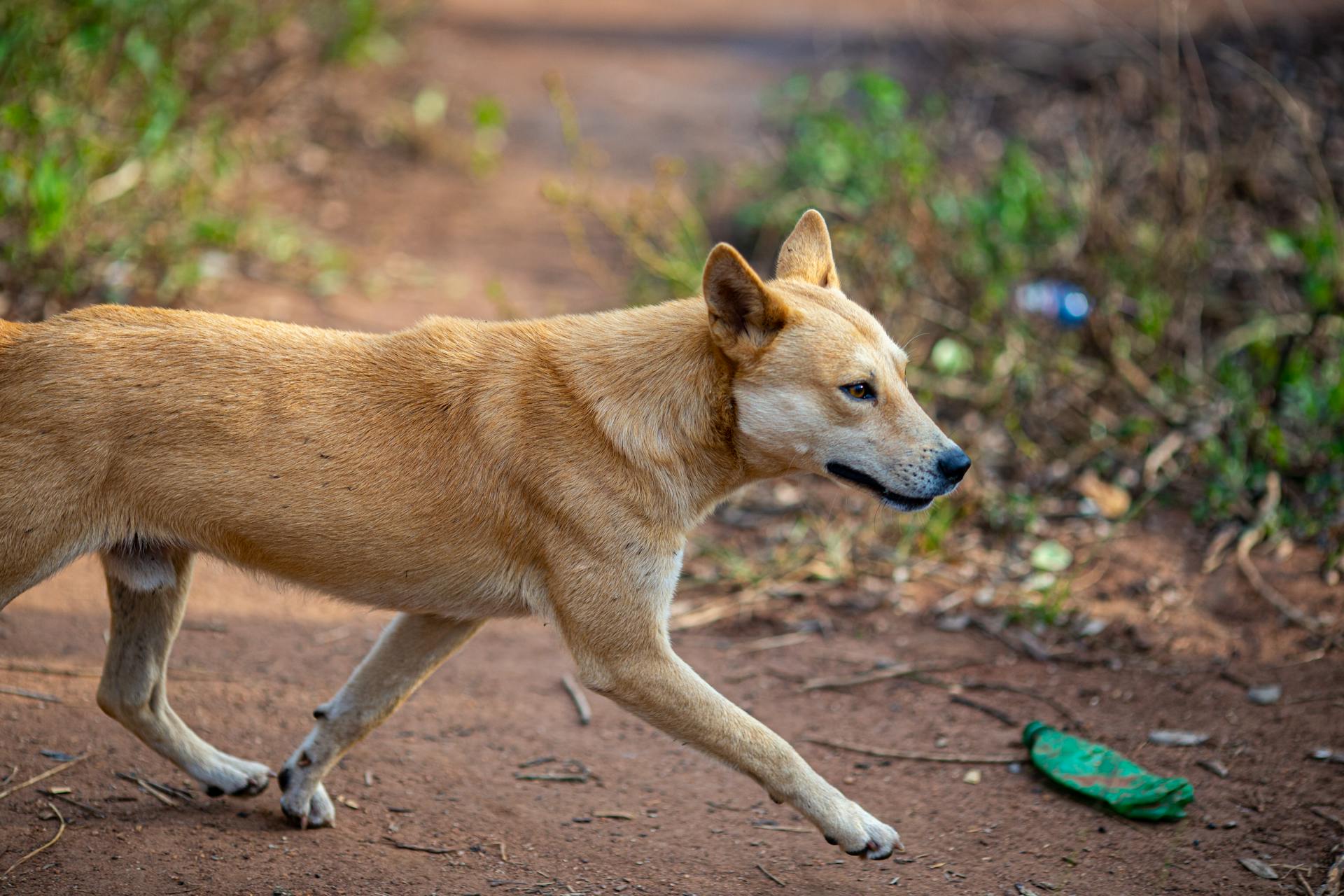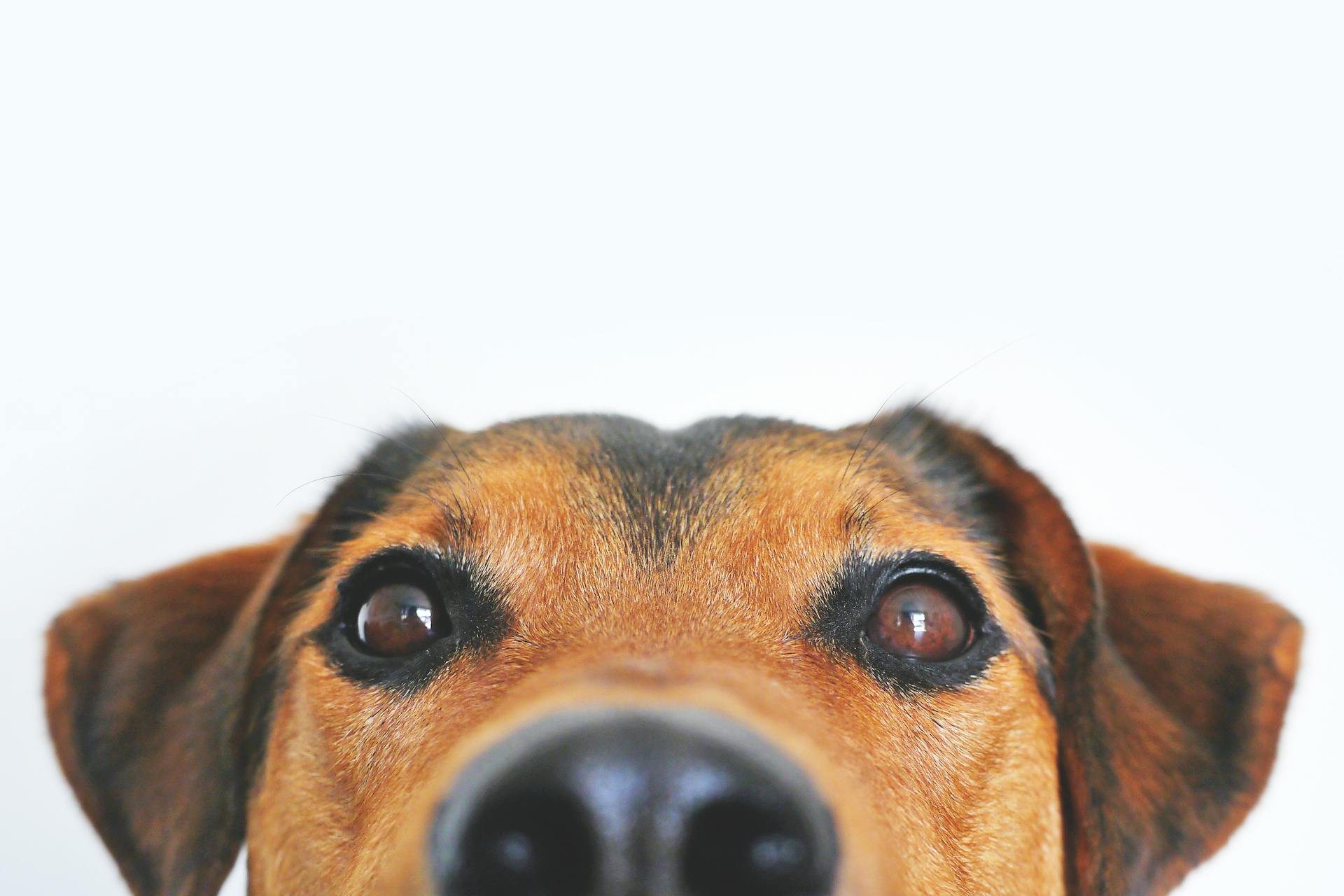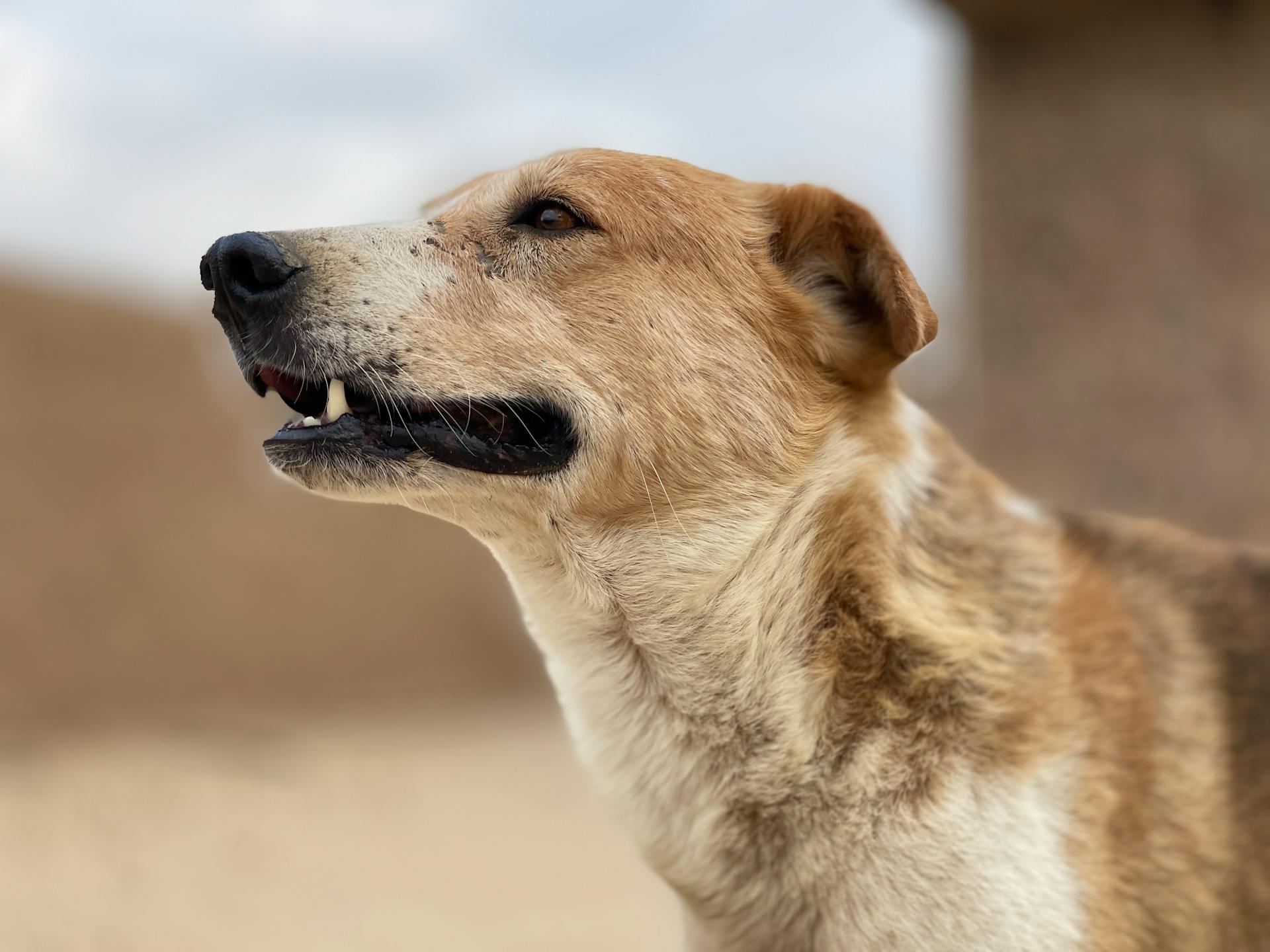
Native Indian dogs are a unique and fascinating breed, originating from the indigenous peoples of North America. They're often referred to as "Native American dogs" or "Indian dogs", but it's essential to note that these terms are somewhat outdated and not universally accepted.
These dogs have been a vital part of Native Indian culture for centuries, serving as companions, hunting partners, and even sacred animals. They're highly adaptable and can thrive in a variety of environments, from the Arctic tundra to the scorching deserts of the Southwest.
Native Indian dogs come in a range of sizes, from small to large, and can have a variety of coat types, including short, smooth coats and longer, thicker coats. Their intelligence, loyalty, and strong prey drive make them excellent hunting companions, but they also make great family pets for active families.
Check this out: Native American Girl Dog Names
Origin & History
The Native American Indian Dog has a rich history that spans thousands of years. It is believed that these dogs existed in North America as early as 30,000 years ago.
Originally, these dogs were used by Native American tribes for various purposes, including pulling sleds, serving as guardians, and hunting partners. They were also valued as companions.
The original breeds interbred with dogs introduced from Europe, and most eventually went extinct. This loss of the original breeds is a significant part of their history.
The Native American Indian Dog is a result of breeders' efforts to recreate and preserve a dog similar to the historical Native American breeds. This effort began in the late 20th century.
The breed is still not recognized by the American Kennel Club (AKC) as a purebred breed. However, it is recognized by other registries, such as the Native American Indian Dog Registry, the National Kennel Club, and the Dog Registry of America.
A fresh viewpoint: Native Mountain Dogs
Temperament and Behavior
The Native American Indian Dog is highly intelligent and eager to please, making them a joy to train and interact with. They bond closely with their humans and are social animals that thrive in the company of others.
Their intelligence is one of their most notable traits, and they excel in activities that stimulate their minds. They're quick to learn and can be trained for various tasks and sports.
These dogs are fiercely loyal and devoted to their families, forming strong bonds with their human companions. They're known to be protective of their loved ones and make excellent guard dogs.
Despite their protective instincts, Native American Indian Dogs are generally gentle and friendly, making them a great fit for families with children. Proper socialization from an early age is key to ensuring their friendly nature extends to other animals and strangers.
They possess a keen sense of awareness, making them excellent watchdogs and alerting their owners to any potential dangers or unusual activities in their surroundings. Their adaptability also makes them a great fit for various living environments, including apartments and houses.
Regular exercise is essential to keep them physically and mentally stimulated, and daily walks, playtime, and engaging activities like agility or obedience training are recommended.
Take a look at this: Dog Food Making Dogs Sick
Care and Compatibility
Family life with a Native American Indian Dog can be wonderful, as long as you're willing to put in the time and effort. They make excellent family dogs, loving and loyal to their family members.
These dogs are naturally protective, but this can be trained out of them with proper socialization. They're also wary of strangers, which can be a challenge if you don't socialize them properly.
Native American Indian Dogs love children and other animals, making them a great addition to families with multiple pets. However, they do need socialization to get along with new people and animals.
They're highly energetic and need plenty of exercise, so be prepared to take them on long hikes, runs, and swims. They'll also love playing with interactive toys and games, making them the perfect exercise buddy.
Unfortunately, their high energy needs and socialization requirements make them a less-than-ideal choice for first-time owners. But with the right experience and dedication, a Native American Indian Dog can be a loving and loyal companion.
A fresh viewpoint: Shiba Inu Exercise Needs
Training and Socialization
Training and socialization are crucial aspects of raising a Native American Indian Dog. Start early, and begin training and socializing your pup from a young age.
American Indian Dogs respond best to positive reinforcement training methods, using rewards like treats, praise, and play to motivate and encourage desired behaviors. Avoid harsh or punitive training techniques, as they can be detrimental to their sensitive nature.
Teach your Native American Indian Dog basic obedience commands like "sit", "stay", "come", and "heel." These commands establish communication and control, making them easier to manage in different situations.
Native American Indian Dogs are intelligent and thrive on mental challenges, so engage them in interactive games, puzzle toys, and training activities that stimulate their minds. This helps prevent boredom and destructive behaviors.
Proper leash training is essential to ensure your Native American Indian Dog walks calmly on a leash without pulling. Gradually introduce them to wearing a collar or harness and teach them to walk beside you.
Readers also liked: Teach Dog
Exposing your Native American Dog to other dogs in controlled and supervised environments is a great way to socialize them. Organize playdates, visits to dog parks, or join training classes to provide opportunities for positive interactions and socialization with other canines.
Consistency is key in training a Native American Indian Dog. Establish clear rules and boundaries, and reinforce them consistently, remaining patient and understanding as each happy dog learns at their own pace.
Grooming
The Native Indian Dog's thick double coat requires regular brushing to prevent matting and tangling. They are low-shedding dogs, but they do shed slightly all year round.
Weekly brushing is necessary to remove loose hairs and prevent shedding from becoming a problem. Their coats also help them regulate their body temperature.
During the spring, they will blow out their winter coats and shed heavily for about a week, requiring daily brushing to remove loose hairs. This is a normal process and not a cause for concern.
Their coats are very clean and they don't require frequent baths, unless they get muddy. You should clip their nails as often as needed to prevent overgrowth.
Brushing their teeth often is also important to prevent dental decay and disease. Dental sticks can be a convenient option for making this a regular habit.
Broaden your view: Best Soft Food for Dogs after Dental Surgery
Animal Aggression
Animal Aggression is a common issue that can arise in any dog, including the Native Indian Dog. They can be protective of their family and territory, which may lead to aggression towards strangers.
Native Indian Dogs are naturally wary of strangers and may take time to warm up to new people. This is due to their strong instinct to defend their pack.
Their guarding instincts can sometimes get the best of them, causing them to become aggressive in certain situations. For example, if they feel their family is being threatened, they may become defensive.
Native Indian Dogs are generally calm and gentle with their family members, but they can be quite assertive when it comes to protecting them. This is a key characteristic of their breed.
Their independent nature can sometimes make them appear aloof or standoffish, but this is just a result of their strong instincts and loyalty to their family.
For your interest: Dog Names for Strong Dogs
Breed Development and Preservation
The American Indian Dog has a rich history and cultural significance, making its preservation essential. This breed is deeply rooted in Native American culture and traditions.
Preserving the American Indian Dog breed ensures the maintenance of its genetic diversity, which is crucial for the long-term health and vitality of the breed. This diversity is a result of its ancestral origins and careful breeding practices.
These dogs have historically served as valuable working companions for indigenous peoples, with abilities such as hunting, herding, and guarding. By preserving the breed, we can ensure that these working abilities are preserved for future generations.
Their loyal, intelligent, and gentle nature makes them excellent family pets, and preserving the breed ensures that these unique qualities are available to those who appreciate their exceptional characteristics.
Similar Breeds Developed
The Native American Indian Dog is a rare breed, and it's not the only one inspired by ancient Native American dogs. The NAID is closely related to other breeds like the American Indian Dog and the Native American Village Dog.

These breeds are similar to NAIDs, but none of them is officially recognized by a kennel club yet. They're all considered rare gems, known for their sweet, gorgeous, smart, and loving nature.
If you're considering bringing one of these breeds into your home, keep in mind that they require space to run in a fenced yard. They also need owners who are comfortable socializing and training their dogs.
The American Indian Dog, for example, is a great companion for individuals and families, but it's not suitable for every living situation.
Preserving the Breed
The American Indian Dog is a vital part of Native American culture and traditions, serving as a link to their heritage and a reminder of their profound relationship with dogs.
By preserving the breed, we honor the historical and cultural significance it holds for indigenous communities.
Genetic diversity is a hallmark of the American Indian Dog, thanks to its ancestral origins and careful breeding practices.
This diversity is essential for the long-term health and vitality of the breed, making preservation crucial.
American Indian Dogs have historically served as valuable working companions for indigenous peoples, with working abilities like hunting, herding, and guarding that are still preserved today.
Their loyal, intelligent, and gentle nature makes them excellent family pets, and preserving the breed ensures that these unique qualities are available to those who appreciate their exceptional characteristics.
By supporting the preservation of the American Indian Dog, we contribute to broader conservation efforts for indigenous and rare dog breeds, fostering awareness about the importance of maintaining genetic diversity and protecting cultural heritage.
Three Little-Known Facts
Here are three little-known facts about breed development and preservation that I've learned from my research.
The first fact is that many breeds were developed for specific working purposes, but their original jobs are often forgotten. For example, the Old English Sheepdog was originally bred to herd sheep and guard farms.

The second fact is that breed development is often a slow and deliberate process, taking centuries to refine a breed's characteristics. This is evident in the case of the Greyhound, which was developed over 2,000 years ago for speed and agility.
The third fact is that even though many breeds are now kept as pets, their original working abilities are still worth preserving. The example of the Border Collie, which was developed to herd sheep and other livestock, shows that with proper training and exercise, these breeds can still excel in their original roles.
Frequently Asked Questions
What dog is native to India?
The Indian pariah dog is a native breed found in the Indian subcontinent, characterized by its distinctive features such as erect ears and a curved tail. Learn more about this ancient and resilient landrace of dog.
Are Native American Indian Dogs protective?
Yes, Native American Indian Dogs can be protective of their family, but proper socialization is key to helping them feel comfortable around strangers.
How long does a Native American Indian Dog live?
Native American Indian Dogs typically live between 14 and 19 years, making them a long-lived breed. Their above-average lifespan is a notable characteristic of this unique dog.
Featured Images: pexels.com


